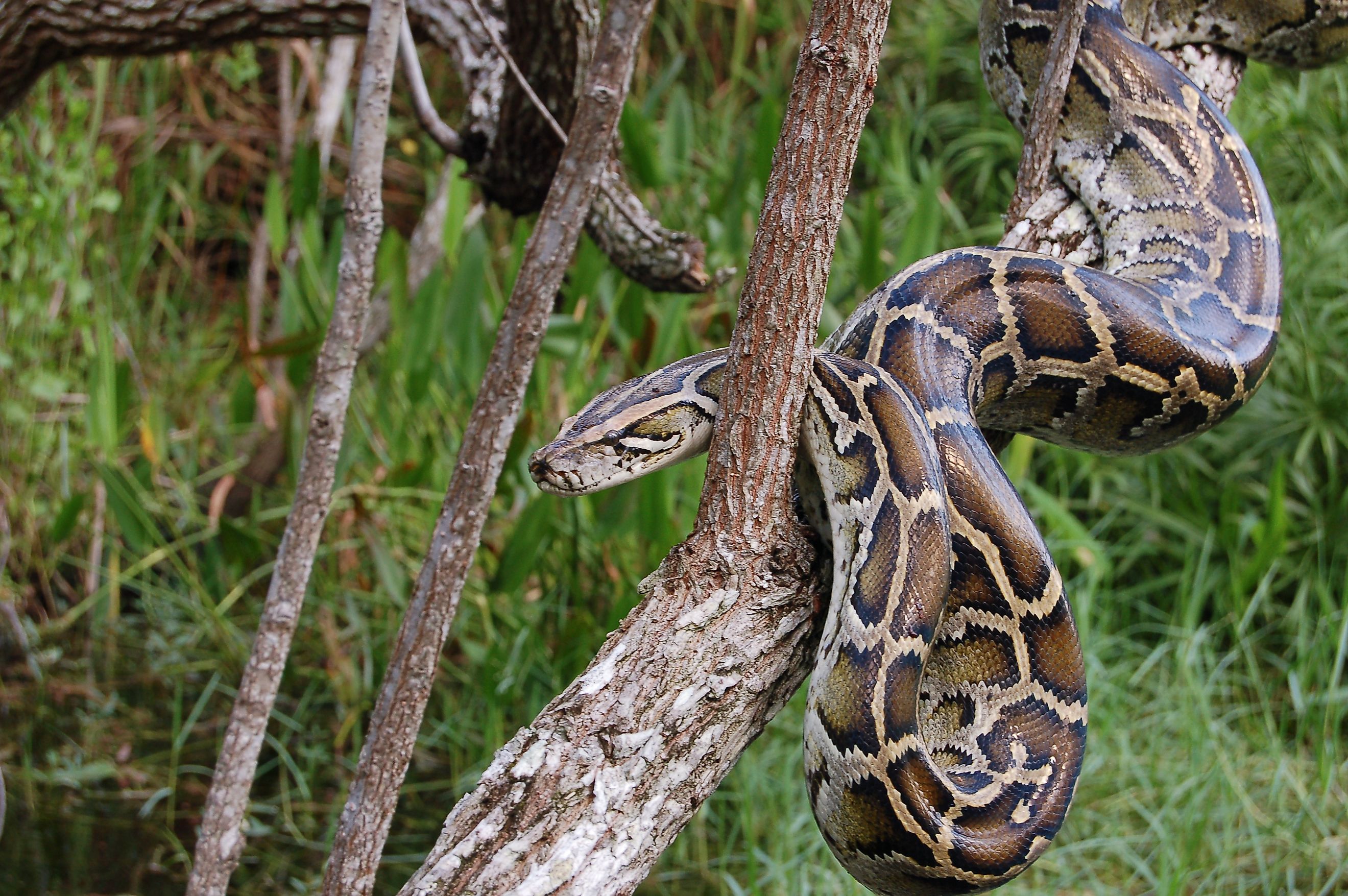
Invasive Species In The Florida Everglades
Home to around 350 species of birds, 300 species of fish, 50 species of reptiles, and 40 species of mammals, the Everglades is one of the most biodiverse areas on the North American continent. However, among these species, 180 are classified as threatened or endangered by the State of Florida, largely due to the impact of invasive species. An invasive species disrupts ecosystems and endangers native species and habitats, posing significant threats to the environment. Currently, 32 invasive species are wreaking havoc in the Everglades, further endangering the survival of hundreds of native species.
Invasive Animal Species in the Everglades
| Scientific Name | Common Name | Origin and Year Introduced | Class |
|---|---|---|---|
| Corbicula fluminea | Asiatic clam | China, 1961 | Invertebrate |
| Metamasius callizona | Bromeliad beetle, evil weevil, Mexican weevil | Mexico & Central America, 1989 | Invertebrate |
| Paratachardina lobata lobata | Lobate lac scale | India & Sri Lanka, 1999 | Invertebrate |
| Pomacea insularum | Island apple snail | South America, 2000s | Invertebrate |
| Pterygoplichthys multiradiatus | Suckermouth catfish, armored catfish | South America, 1950s | Fish |
| Clarias batrachus | Walking catfish | Thailand, 1960s | Fish |
| Oreochromis aureus | Blue tilapia, Israeli tilapia | Africa & Middle East, 1961 | Fish |
| Cichlasoma urophthalmus | Mayan cichlid | Mexico & Central America, 1983 | Fish |
| Anolis equestris | Knight anole | Cuba, 1952 | Reptile |
| Iguana iguana | Green Iguana | Central America, 1960s | Reptile |
| Gekko gecko | Tokay gecko | Southeast Asia, 1965 | Reptile |
| Python bivittatus | Burmese python | Southeast Asia, 1979 | Reptile |
| Eunectes murinus | Green anaconda | South America, 2000 | Reptile |
| Salvator merianae | Argentine tegu | Argentina, 2013 | Reptile |
| Cairina moschata | Muscovy duck | South or Central America, 1960s | Bird |
| Myiopsitta monachus | Monk parakeet, quaker parrot | South America, Established by 1969 | Bird |
| Sus scrofa | Wild boar, feral pig | Europe, 16th century | Mammal |
| Felis catus | Domestic/Feral Cat | North Africa and Southern Europe, 16th Century | Mammal |
| Rattus rattus | Black rat, roof rat, house rat, ship rat | Europe, 16th Century | Mammal |
Invasive Plant Species in the Everglades
| Scientific Name | Common Name | Origin and Year Introduced |
|---|---|---|
| Pistia stratiotes | Water lettuce, water cabbage | Africa or South America, 1765 |
| Schinus terebinthifolius | Brazilian pepper, Florida holly, Christmas berry, pepper tree | Brazil, Argentina, Paraguay, 1840s |
| Casuarina equisetifolia, Casuarina glauca, Casuarina cunninghamiana | Australian pine, beefwood, ironwood, she-oak, horsetail tree | Australia, South Pacific Islands, Southeast Asia, Late 19th century |
| Eichhornia crassipes | Water hyacinth, water orchid | Amazon Basin, 1884-1890 |
| Dioscorea bulbifera | Air potato, potato yam, air yam | Asia, 1905 |
| Melaleuca quinquenervia | Melaleuca, paperbark, tea tree, cajeput, punk tree, white bottlebrush tree | Australia, New Guinea, the Solomon Islands, 1906 |
| Neyraudia reynaudiana | Burma reed, silk reed, cane grass, false reed | Southern Asia, 1916 |
| Rhodomyrtus tomentosa | Downy rose myrtle, downy myrtle, hill gooseberry, hill guava | Asia, 1924 |
| Colubrina asiatica | Latherleaf, Asiatic or common colubrina, hoop with, Asian snakeroot | Asia, In Southern Florida by 1933 |
| Hydrilla verticillata | Hydrilla, water thyme, Florida elodea, waterweed | Sri Lanka, 1950s |
| Lygodium microphyllum | Old World climbing fern | Tropical Asia, Africa, and Australia, Observed already established in 1958 |
| Cupaniopsis anacardioides | Carrotwood, beach tamarind, green-leaved tamarind, tuckeroo tree | Australia, 1960s |
Invertebrates
Asiatic Clam (Corbicula fluminea)
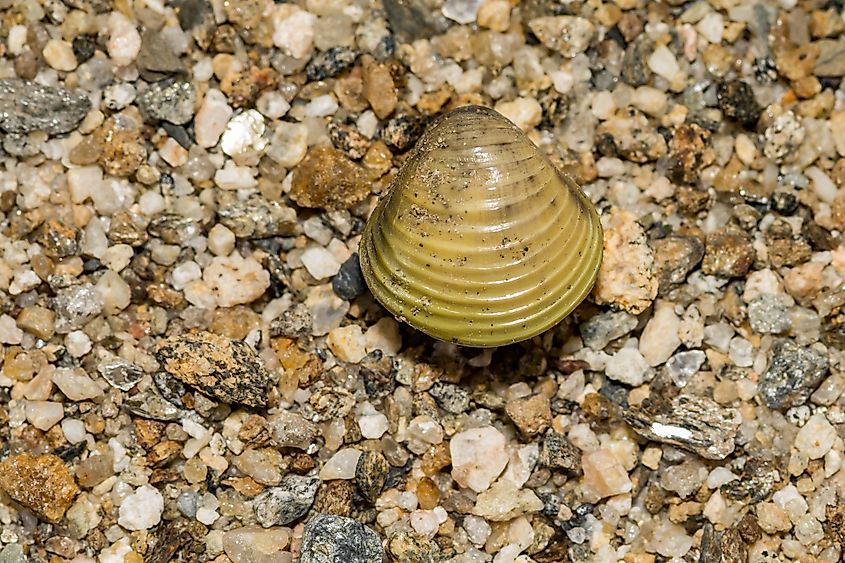
Although existing in North America for decades, the asiatic clam only recently arrived in Southern Florida. Growing up to two inches in length, they are yellow-green and brown in color with rings along their shells. Their rapid reproduction is driving the native Chironomidae fly out of its habitat, as the fly can no longer burrow effectively due to the clam's overwhelming presence. They also concentrate around pipes and canals, causing irrigation and water supply problems in southern Florida.
Bromeliad beetle (Metamasius callizona)
The Mexican bromeliad weevil, sometimes referred to as the bromeliad beetle or the “evil weevil” due to the destruction it has caused to Florida’s bromeliads, was first identified in Florida in 1989. It is believed to have been introduced following a shipment from Veracruz, Mexico. Adults range from 11 to 16 mm long and are black, marked by a single yellow or orange stripe in the middle of its back. The presence of Metamasius callizona has resulted in the endangerment of two Florida bromeliad species and threatens some of the state’s rarest bromeliads within the Everglades.
Lobate lac scale (Paratachardina pseudolobata)
An employee of the Florida Department of Agriculture and Consumer Services first found lobate lac scale, a scale insect, on a hibiscus plant in Florida in August 1999. Although personnel destroyed the hibiscus, they returned to find lobate lac scale in the following years. Mature, the lobate lac scale grows to be about 1.5 to 2 millimeters long and has a dark brown and reddish shell. They typically infest the woody parts of small branches and twigs of dicotyledonous plants, with heavy infestations being found on the eastern edge of the Everglades, threatening native plant life.
Island Apple Snail (Pomacea maculata)
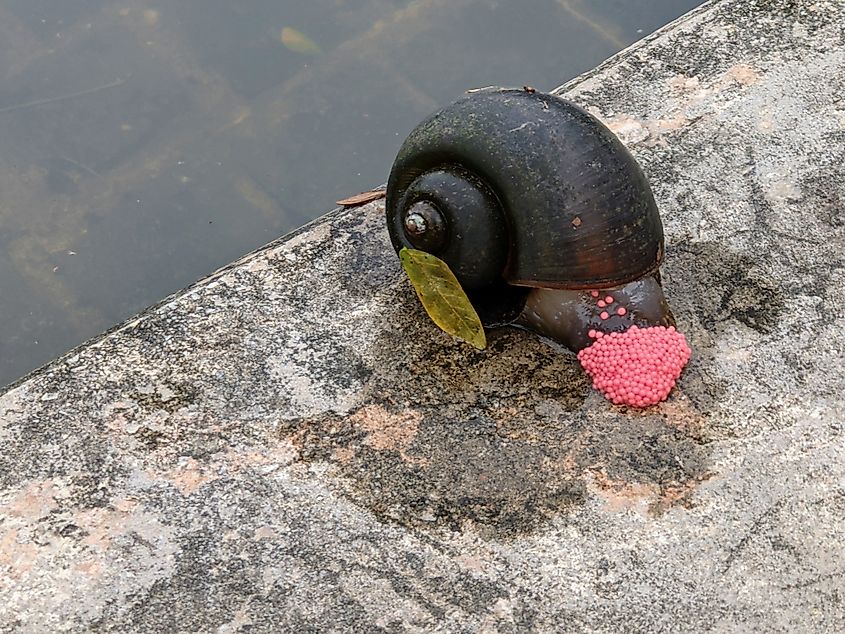
The island apple snail has a very similar appearance to the native Florida Apple Snail, making it very difficult at times to differentiate the two. It is larger than the majority of freshwater snail species and has an oval-shaped, dark brown shell, most likely mistakenly introduced by people in the tropical pet fish industry. The invasive island apple snail primarily feeds on rooted aquatic plants and has few natural predators within the Everglades. The species threatens the native Everglades snail kite, a bird species that traditionally feeds on the Florida apple snail. However, with declining numbers of its usual prey, the snail kite has increasingly tried to eat the non-native island apple snail. This shift presents dietary challenges due to the larger shell size of this invasive species.
Fish
Suckermouth Catfish (Pterygoplichthys multiradiatus)
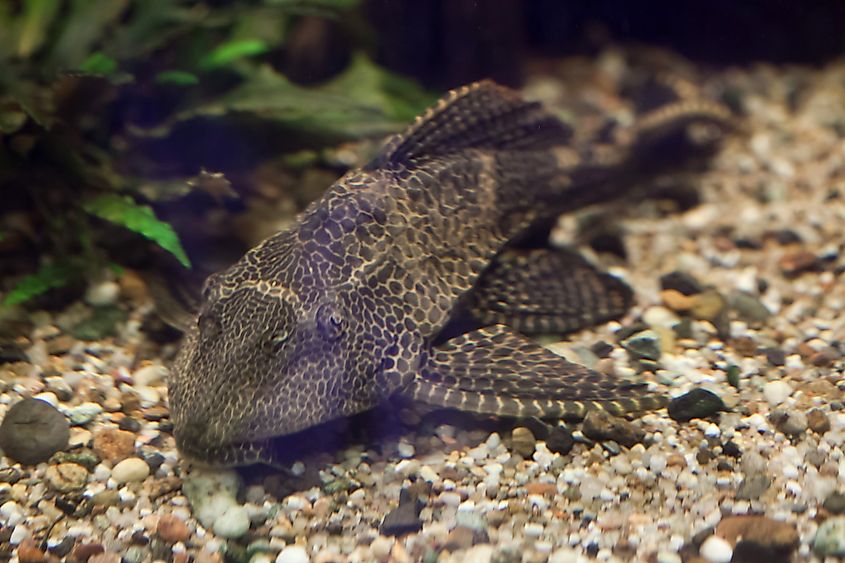
The suckermouth catfish, also known as the sailfin catfish, was most likely introduced to the United States during the aquarium trade in the 1950s. They are brown in color with black, bony-like plates and typically grow up to two feet in length. They serve as aquarium cleaners, consuming algae and weeds, but pose a threat to smaller native species in the Everglades that compete with them for food. Their bony fins can injure native birds that attempt to eat them, with several brown pelicans found having choked on these fish. That said, a study in the early 21st century indicated that the fish did not cause major harm to native fish species, so its effects aren’t as detrimental as they may seem.
Walking Catfish (Clarias batrachus)
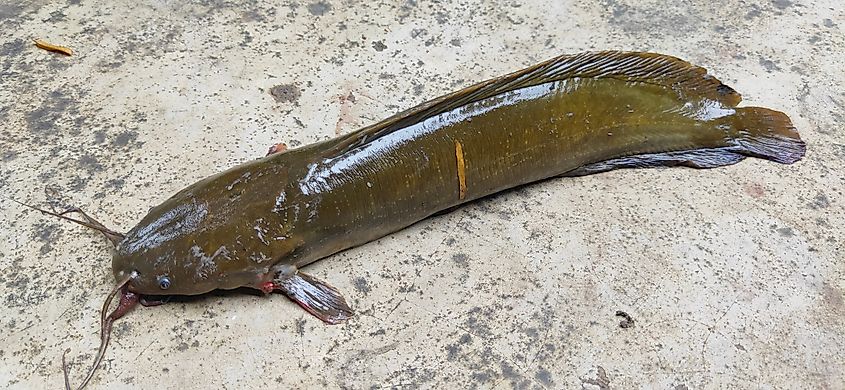
The walking catfish likely arrived in Florida in the 1960s following its escape from aquaculture facilities. As adults, they are slender and elongated, reaching up to 20 inches in length and weighing around 2.5 pounds. Their bodies are grayish-brown with white flecks along the sides, and they have long dorsal fins. Known for their unusual ability to move across moist land to reach other water bodies, they can survive out of water for more than 18 hours. During dry spells in the Everglades, they consume almost anything to survive, often depleting farmers' fish stocks. Additionally, they can carry enteric septicemia, a bacterial infection transmissible to native Everglades fish.
Blue Tilapia (Oreochromis aureus)
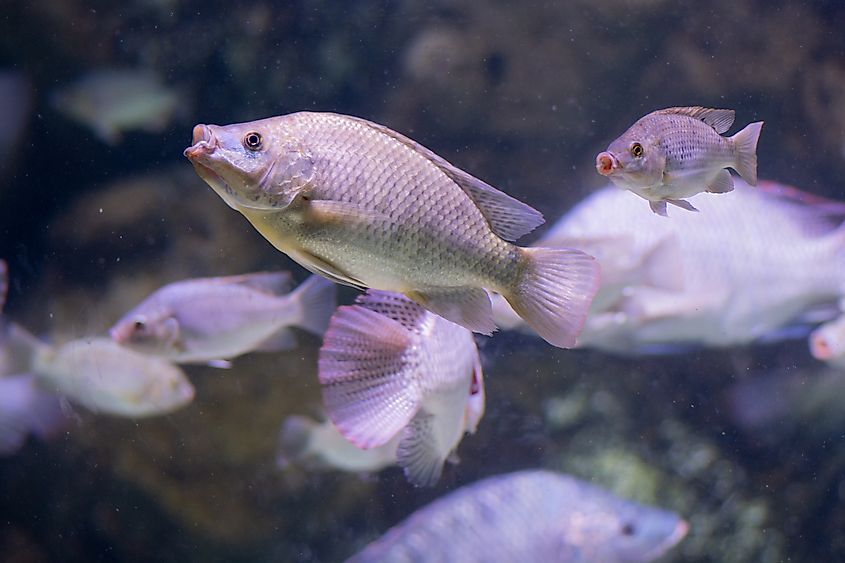
Blue tilapia have been introduced to Florida multiple times for various purposes, including experimental research, sport fishing, and plant control, among other reasons. Adults measure between 4.75 and 7.75 inches in length, displaying a bluish-grey body that fades to white near the belly, with red-bordered dorsal and caudal fins. They are generally considered to be one of the most widespread invasive fish species in Florida. They create wide nest craters, about two feet in diameter, that can impede the growth of native plants and the spawning of native fish.
Mayan Cichlid (Chichlasoma urophthalmus)
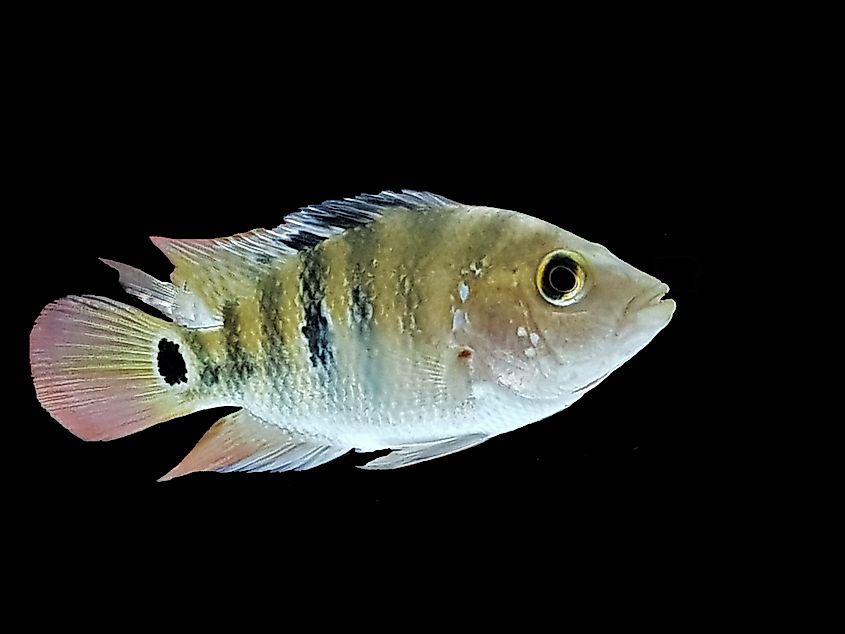
The Mayan cichlid first appeared in Florida Bay in 1983, likely due to aquarium dumping, and has since become rapidly abundant throughout southern Florida. Around 15 inches long, it typically has six to eight dark bars along its back, with a body color that varies widely. A distinctive turquoise ring and a broken lateral line along its tail set it apart from other fish species. They have a varied diet, ranging from grasses to smaller fishes and invertebrates, including the native Florida Apple Snail, whose population is on the decline.
Reptiles
Knight Anole (Anolis equestris)
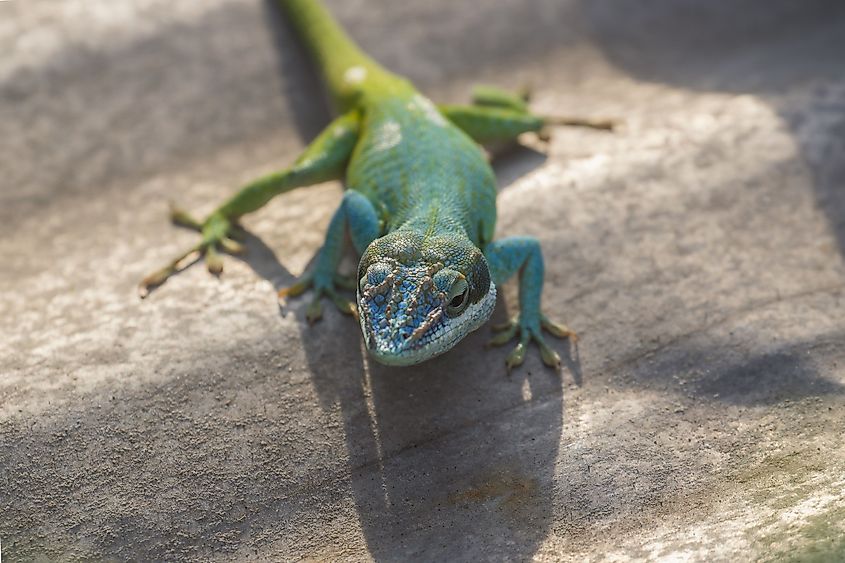
The knight anole, originally from Cuba, was first spotted in Florida around 1952. While the exact cause of its introduction is unclear, experts believe it was either released by a pet owner or arrived as a stowaway on a ship. Larger than native Floridian anoles, they can grow to be between 13 and 20 inches long and are bright green, with a white or yellow strip on their eye and shoulder. The anole eats a variety of native species in the Everglades, competing with and posing a threat to the Everglades native green anole.
Green Iguana (Iguana iguana)
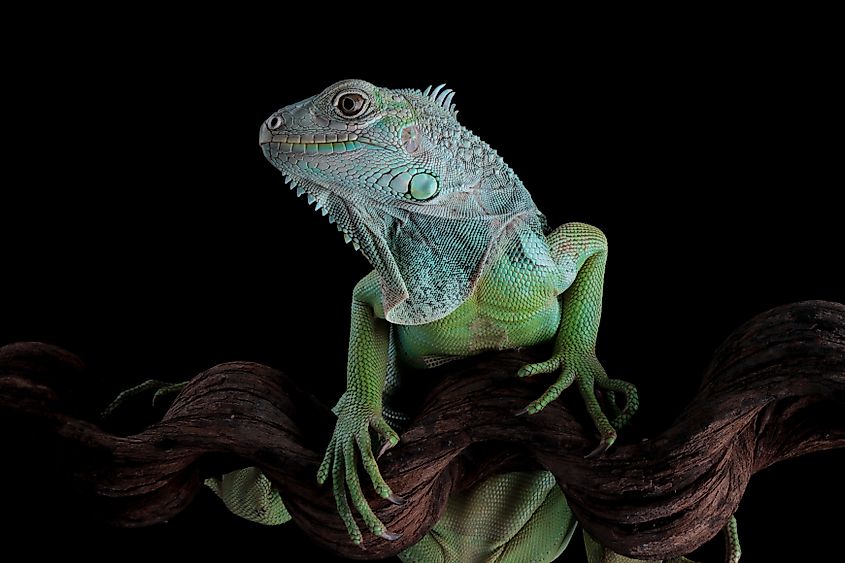
The green iguana was first reported in Florida in the 1960s, likely arriving accidentally on cargo ships from Cuba. After Hurricane Andrew in 1992, their population surged. These iguanas vary in color, including green, reddish brown, lavender, black, and blue, and have a row of spines along their back and tail. Growing up to six feet in length, they are one of the largest iguana species in America. Green iguanas typically inhabit areas near water, where they dig burrows that can disrupt levees and canals. Although primarily plant eaters, they occasionally consume tree snails, posing a threat to the native Florida tree snail species in the Everglades.
Tokay Gecko (Gekko gecko)
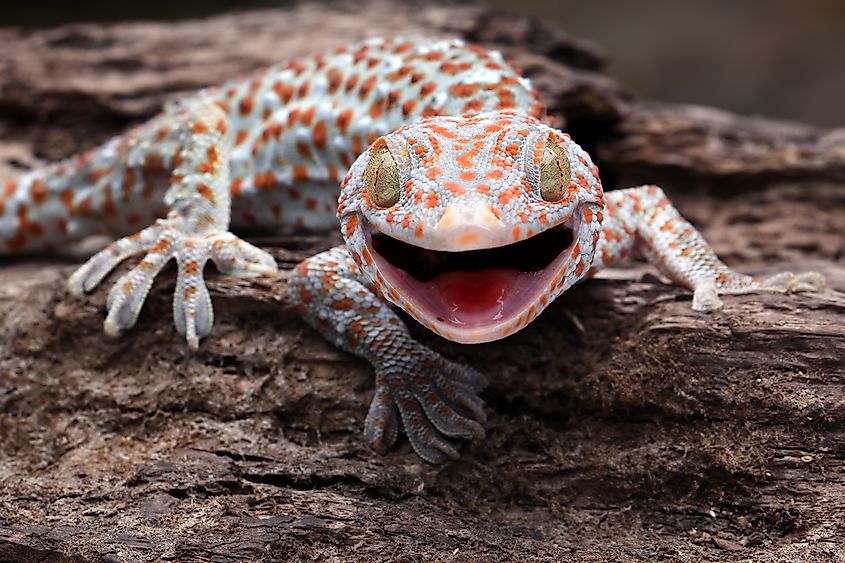
The tokay gecko was introduced in the Florida Everglades in 1965 in an attempt to reduce the rampant cockroach population. However, they have a wide and varied diet in the wild, ranging from birds, frogs, lizards, and other native species. Although they mildly threaten native species in the Everglades, there is not currently a wide-scale attempt to eradicate them. They have cylindrical bodies with well-defined, strong limbs and are covered in spots, growing between 10 and 12 inches long.
Burmese Python (Python bivittatus)
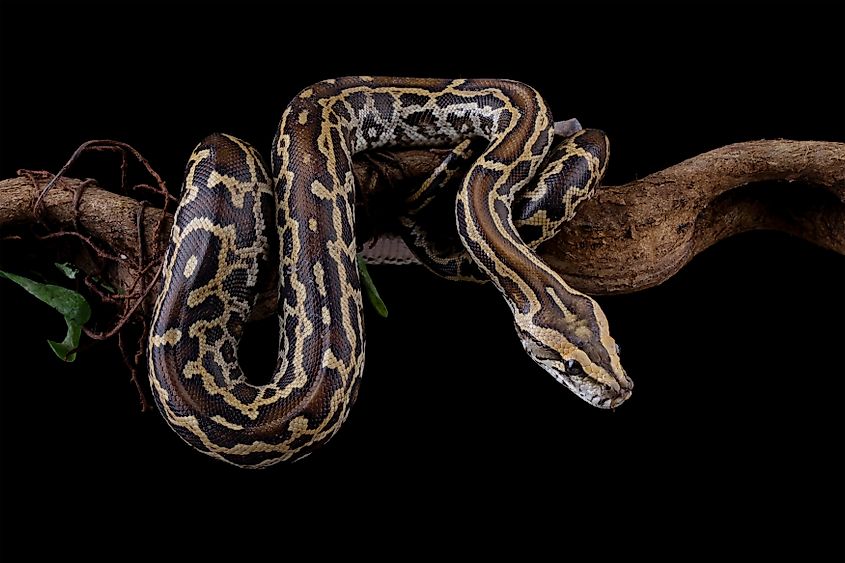
Burmese pythons arrived in the Florida Everglades around 1979 and were most likely the result of accidental or intentional pet releases. They can grow to be 20 feet in length and are brown with dark blotchy spots on their back and sides. Burmese pythons can eat a wide variety of mammals, ranging from wrens to white-tail deer, and have contributed to a severe decrease in native mammal populations in the Everglades, with some species decreasing by up to 90%. The Everglades National Park has spent over 10 years studying how to remove this harmful species from the area.
Nile monitor (Varanus niloticus)
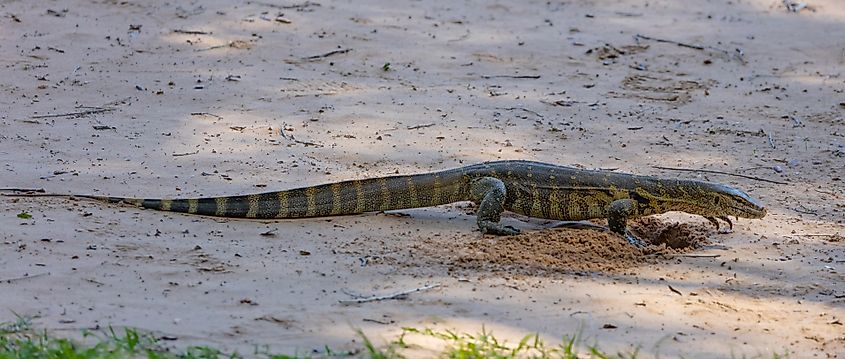
Researchers believe the Nile monitor arrived in Florida around 1990 due to both intentional and accidental releases from captivity. This semi-aquatic lizard is olive green or black with yellowish bands or spots across its back and can grow up to six and a half feet long. They enjoy eating eggs, threatening native species such as the burrowing owl, gopher tortoise, brown pelican, American crocodile, and diamondback terrapin. Due to their diverse diet, high production rate, and ability to travel on land, freshwater, and salt water, they are difficult to eradicate.
Green Anaconda (Eunectus murinus)
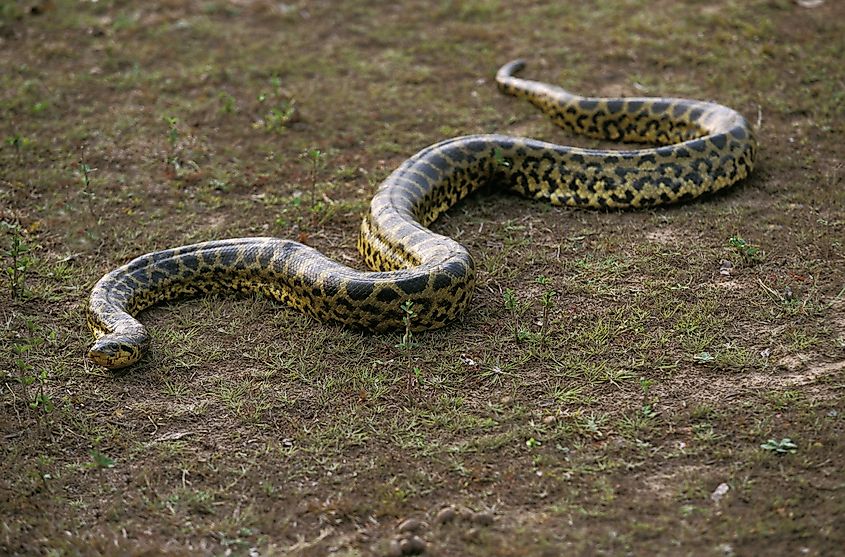
The Green Anaconda was first spotted in the Everglades in 2000, with the population currently on the rise. Most scientists believe its presence in the wild is due to a pet release. The green anaconda has an olive-green body with dark spots along its back, while its belly features yellow and black scales. One of the world’s largest snake species, it can grow up to 26 feet long and weigh up to 500 pounds. With no natural predators, the growth of this population in the Everglades poses a significant threat to the region's native species, as they prey on fish, turtles, mammals, and birds.
Argentine Black and White Tegu (Salvator merianae)
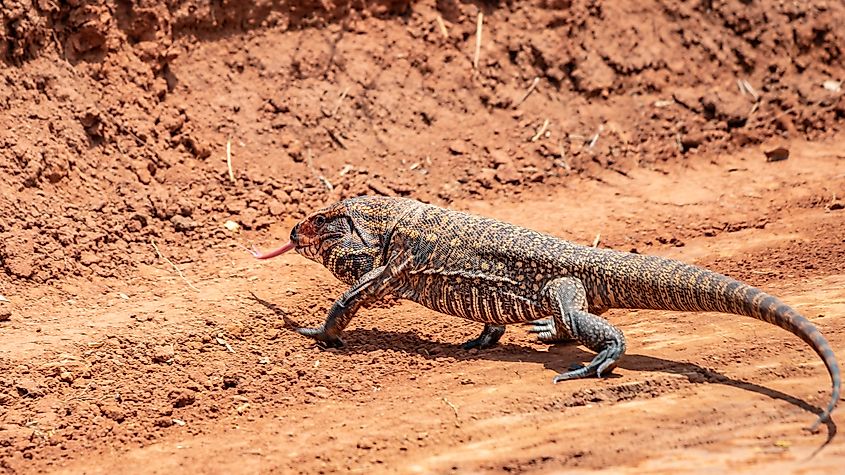
The Argentine black and white tegu arrived in the Everglades around 2013, most likely the result of the exotic pet trade. It is one of the largest lizard types in the Western Hemisphere, reaching nearly five feet long in some cases. They have a blotchy black and white coloration, with bands often down their back and tail. Tegus frequently feed on eggs from native animals’ nests, such as the American alligator, threatening the native species populations. While the species is relatively new in Florida, evidence suggests that the population will grow in the coming years.
Birds
Muscovy Duck (Cairina moschata)
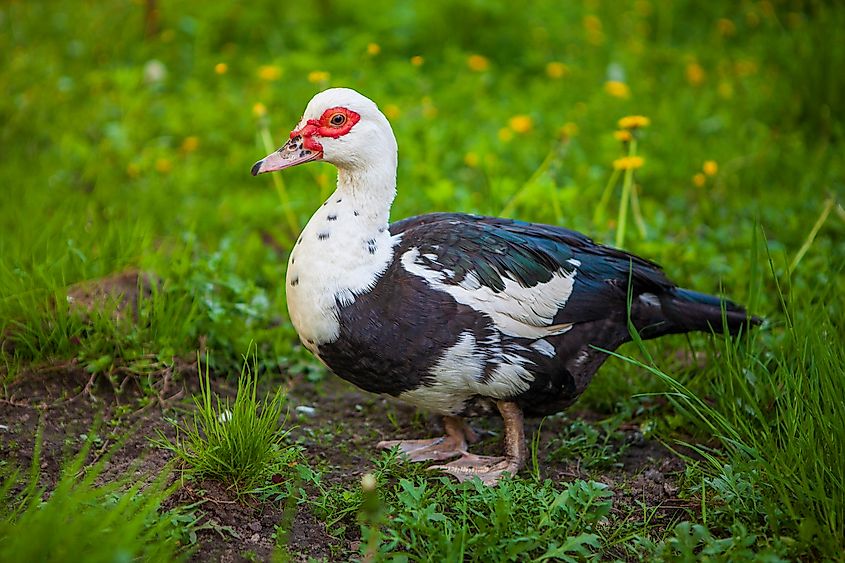
The muscovy duck arrived in Florida intentionally as an ornamental species in urban parks in the 1960s. Although they are native to some parts of North America, they are not native to Florida. These ducks typically have a wingspan between 54 and 61 inches and can weigh up to nine pounds. Their feathers are primarily white to black, adorned with patches of purple, green, and white, and they are characterized by a red, fleshy protuberance on their face. They can spread diseases to native Everglades species and interbreed with native birds, interrupting the natural ecosystem.
Monk Parakeet (Myiopsitta monachus)
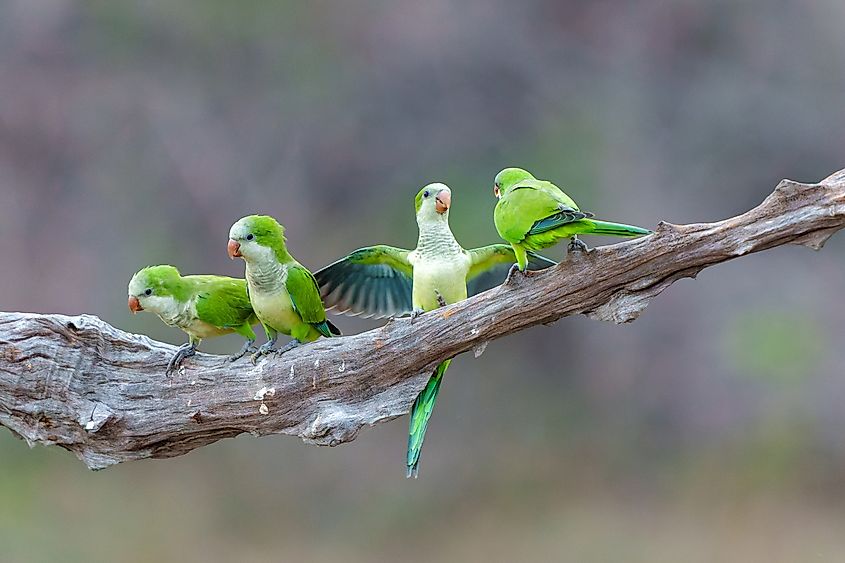
Between 1968 and 1972, the pet trade brought over 64,000 monk parakeets to the United States. This medium-sized bird is typically green and gray and ranges from 11 to 13 inches long. Although cities often consider monk parakeets an urban pest due to their large communal nests on power poles, their impact on the Everglades is not yet fully understood, although they may compete with native wildlife for food. That said, these birds are also highly intelligent and are a common pet throughout most of the United States, due to their availability and subsequent affordability.
Mammals
Wild Boars (Sus scrofa)
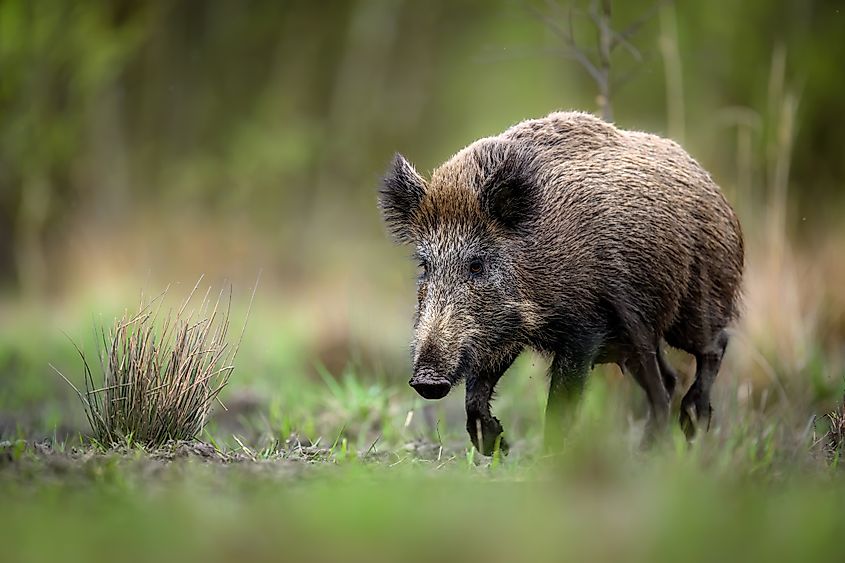
European settlers arrived in the Americas with wild boars during the 16th century. They have large, stocky bodies with grey-brown fur, measure between three and six feet long, and can weigh up to 220 pounds. They can carry 45 different infectious diseases, threatening the native species populations, and have been recorded spreading trichinosis to the endangered Florida panther. The wild boar also commonly plows through the soil in search of food, which can cause unwanted erosion to ponds and stream banks.
Domestic/feral cat (Felis catus)
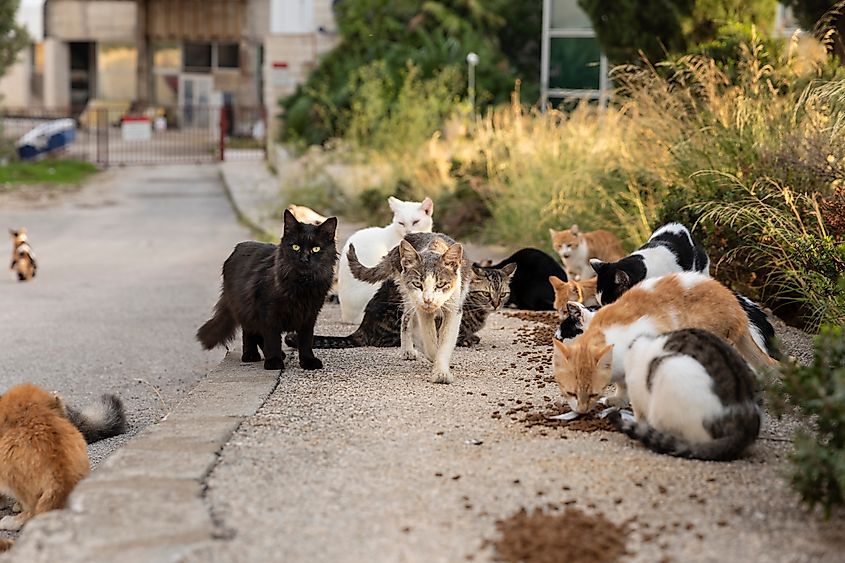
Like the wild boar, cats arrived with European settlers during the 16th century. It is estimated that there are over five million feral cats in the state of Florida. A feral cat's appearance is very similar to a house cat, but they are typically more muscular and may have scars as a result of feral catfights. These cats lower the numbers of several small mammal populations, including cotton mice, beach mice, the Florida scrub jay, and the endangered Lower Keys marsh rabbit. They can also carry and spread diseases to other native cats in the Everglades area, including the bobcat and Florida panther.
Black Rats (Rattus rattus)
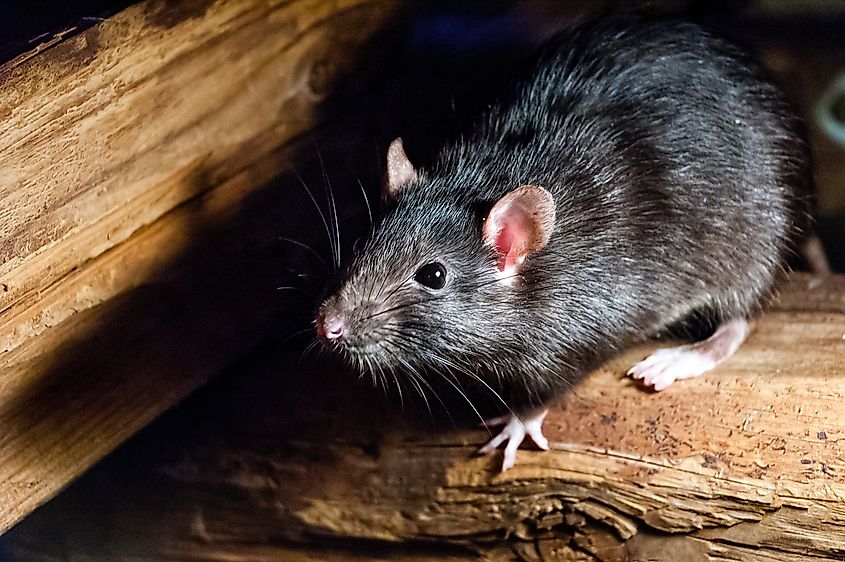
Arriving in early European settlers’ ships, black rats, also known as house rats, were among the first non-native animals to arrive in Florida. Their fur ranges from black to light brown, and they are between five and seven inches in length and 2.6 to 8.1 ounces in weight. Although there are a few other feral rat species in the state, the black rat is by far one of the most populous. This invasive species competes with native rodents for shelter and food, particularly threatening the Key Largo woodrat, an endangered species.
Plants
Water Lettuce (Pistia stratiotes)
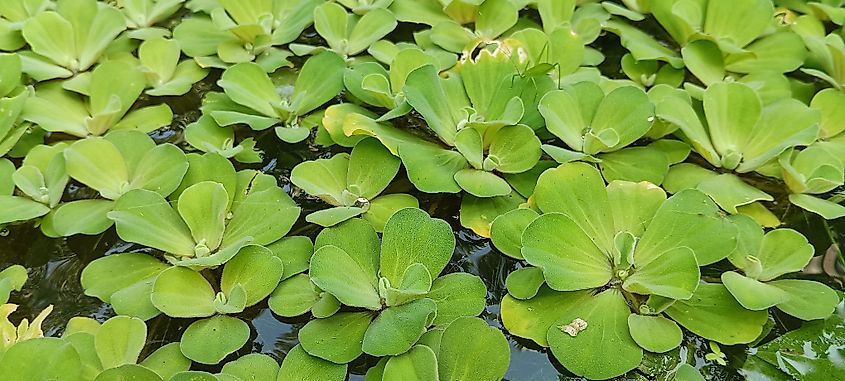
Water lettuce has fuzzy, pale green leaves that cluster together to form dense, floating mats. The plant's earliest appearance was recorded around the 1770s, likely as a result of shipping commerce between North and South America. The dense clusters of water lettuce can lower oxygen levels, reduce aquatic life, restrict water flow, and displace native species. Statewide control efforts have helped keep water lettuce populations relatively managed in the Everglades.
Brazilian Peppertree (Schinus terebinthifolius)
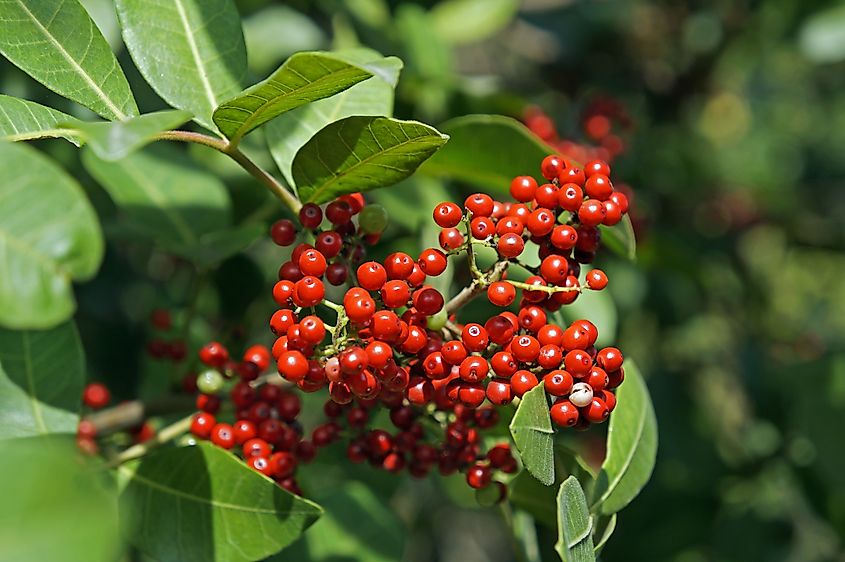
The Brazilian peppertree was introduced to Florida in the 19th century as a landscaping alternative to holly. As an evergreen shrub, it has shiny green leaves, white flowers, and clusters of tiny red fruits. The Brazilian peppertree forms dense canopies growing from 23 to 33 feet tall, blocking sunlight essential for native plant species and releasing chemicals into the soil that inhibit native plant growth. As a result, it often displaces native plants and the animals that rely on them.
Australian Pine (Casuarina equisetifolia)
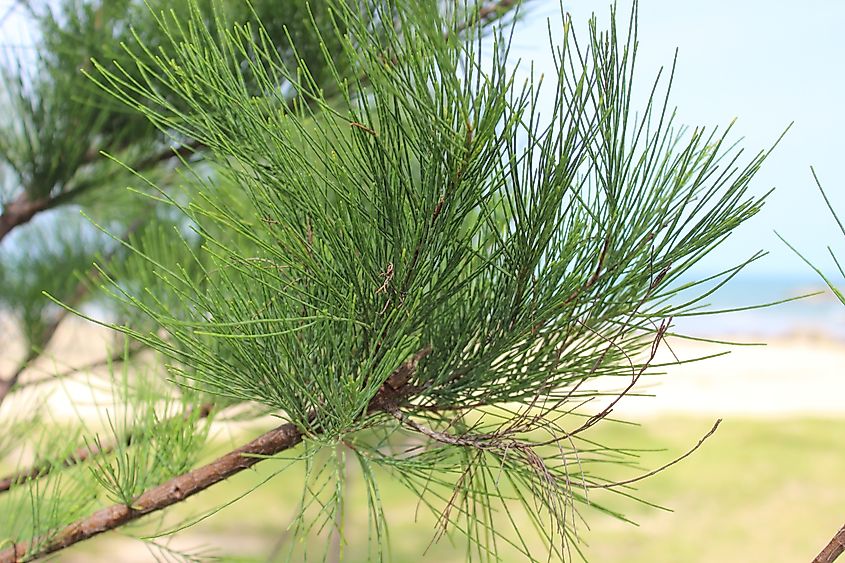
The Australian pine consists of three subspecies, introduced in the late 19th century to stabilize canals and ditches in Florida, and later as shade trees in the 20th century. The species is a deciduous tree that grows over 100 feet tall, with slender, needle-like branchlets and small brown flowers. Due to their rapid growth, they can create dense stands that prevent sunlight from reaching smaller native plants and take over nestling areas from native animals such as the American alligator and sea turtle. Their roots also do not trap sand, like native plant species do, often resulting in higher beach erosion rates.
Water hyacinth (Eichhornia crassipes)
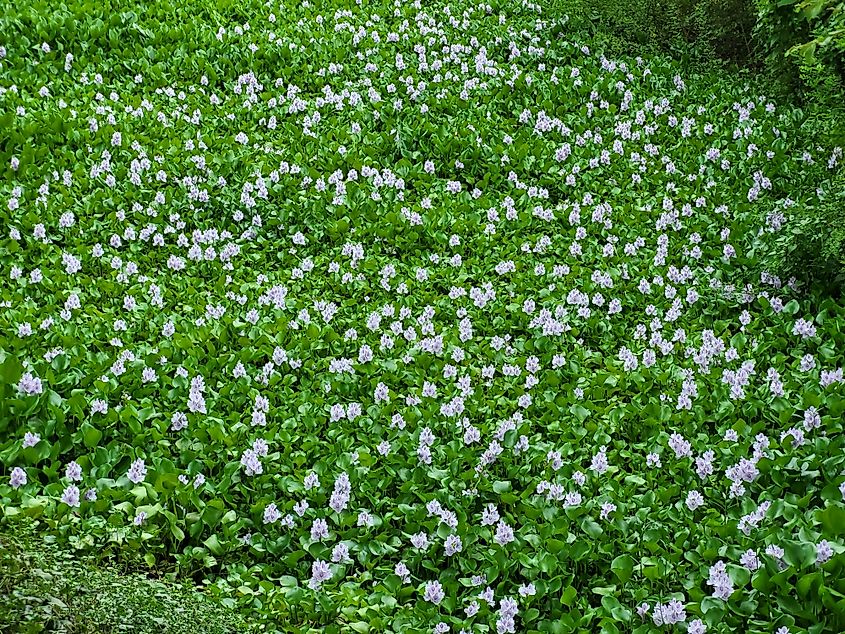
Water hyacinth is a floating plant with spongy stalks, clustered leaves, lavender-blue flowers, and feathery purple roots. The plants typically link together to form dense rafts over mud and water. Introduced to Florida in the 1880s, this species has become a major weed, having one of the highest growth rates among plants worldwide. As it forms dense canopies along the water’s surface, it blocks sunlight for other plants and lowers oxygen levels, threatening aquatic animals.
Air Potato (Dioscorea bulbifera)
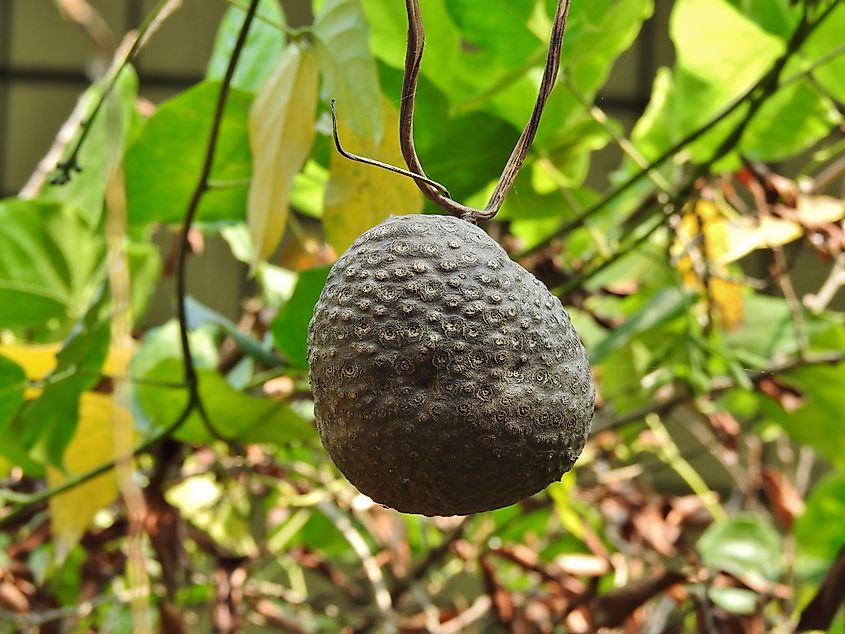
The air potato is a vine characterized by large green leaves that twine around shrubs and trees. It creates canopies that can reach up to 100 feet in height and cut off light to the plants beneath it. It was brought to Florida in 1905 via the slave trade and has been running rampant for over a century in the Everglades. Because of its rapid growth, it can smother entire plant ecosystems and engulf large wooded areas. That said, it is also used as a folk remedy for conditions such as diarrhea and dysentery.
Melaleuca (Melaleuca quinquenervia)
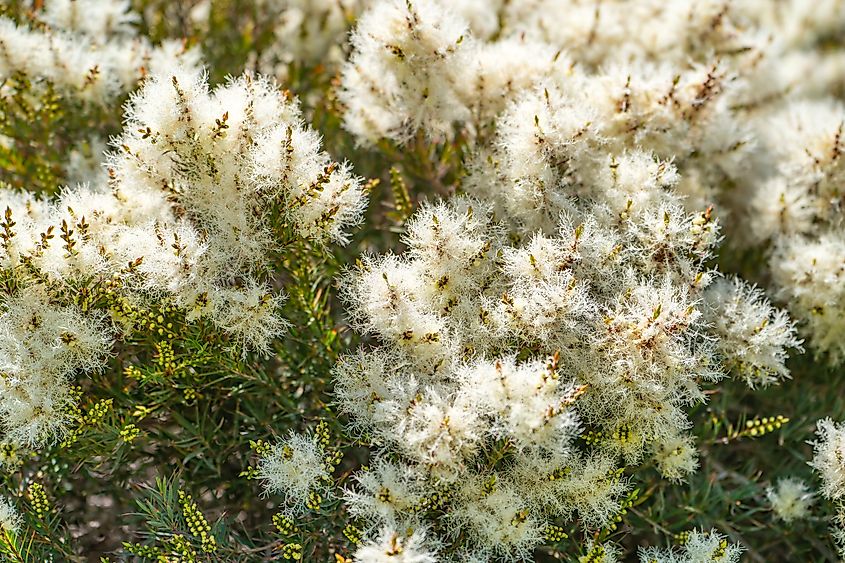
The melaleuca tree, commonly known as paperbark or tea tree, is an evergreen that can grow up to 80 feet in height, with distinctive brownish-white bark and delicate white or cream flowers. Originally introduced to Florida in 1909, it was used for soil stabilization, as an ornamental tree, and as a windbreak. Melaleuca grows rapidly, forming dense, impenetrable stands that displace native plants like sawgrass and cypress, crucial to Everglades ecosystems. Its leaves produce an oil that is a fire hazard, putting neighboring areas and wildlife at risk.
Burma Reed (Neyraudia reynaudiana)
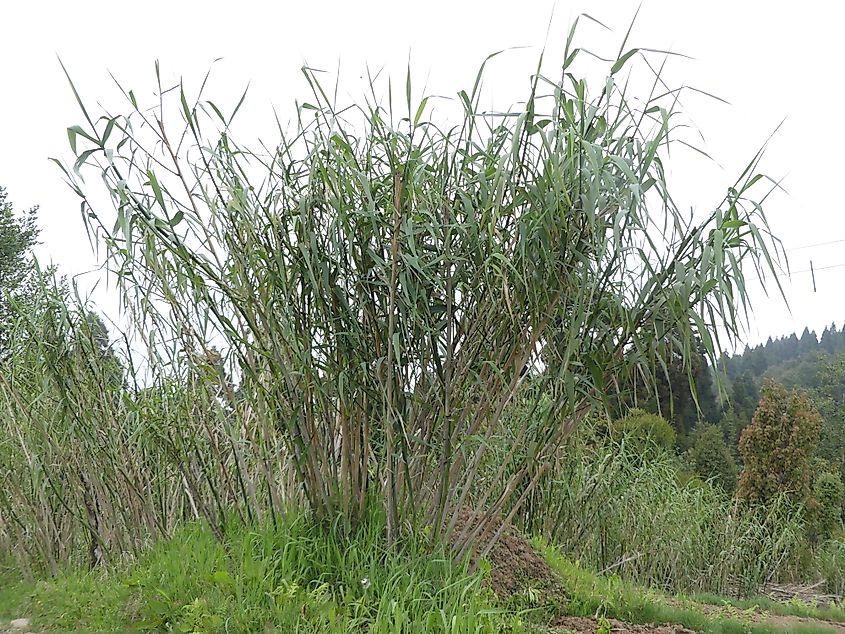
Burma reed, or silk reed, is a towering, perennial grass that can reach heights of up to 15 feet. It was introduced to Florida in the early 20th century to control erosion and as an ornamental plant, but it has since invaded pine rockland areas around the Everglades National Park. Its tall, dense stalks block sunlight, preventing native plants like slash pine from thriving. Additionally, Burma reed’s dense, dry foliage serves as a dangerous fuel for wildfires, often creating hotter and more destructive fires that further damage native vegetation and habitats.
Downy Rose Myrtle (Rhodomyrtus tomentosa)
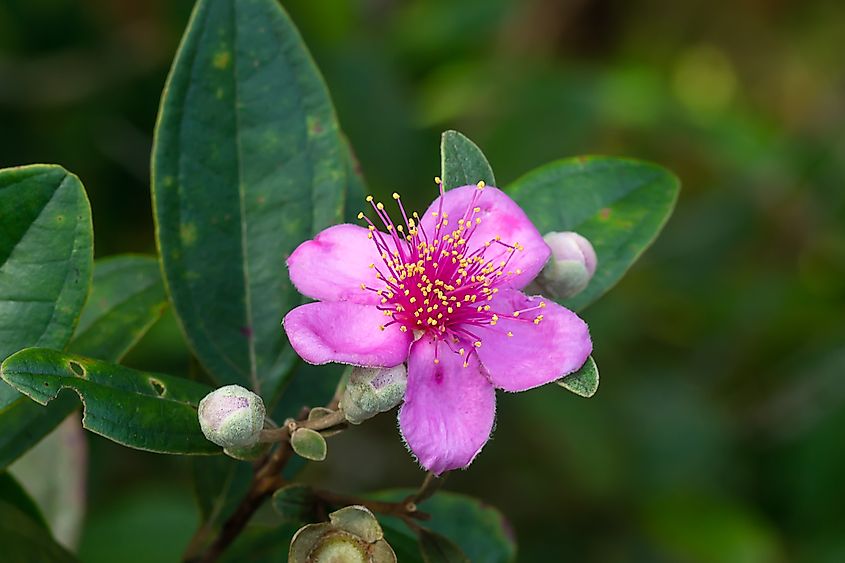
The downy rose myrtle was introduced as an ornamental plant in Florida in the 1920s and quickly became recognized as a priority invasive species. It is a large shrub, growing up to 12 feet tall, with leathery green leaves, pink flowers, and purple berries that resemble blueberries when ripe. Similar to the Burma reed, the downy rose myrtle invades pine rockland ecosystems, particularly displacing saw palmettos. Researchers from the University of Florida have warned that the downy rose myrtle could become much more of a threat in coming years if not adequately controlled now.
Latherleaf (Colubrina asiatica)
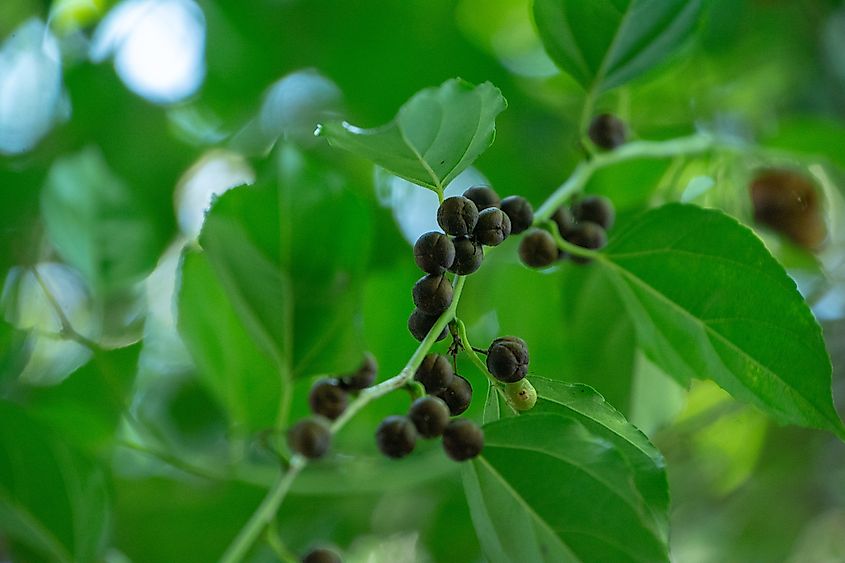
Latherleaf is a sprawling shrub with stems that can reach up to 30 feet long, getting its name from its ability to create a lather-like substance in water. It features shiny green leaves and small clusters of tiny green and white flowers. The plant was originally introduced to Jamaica by Asian traders in the 1850s and later spread to Florida in the 1930s. Forming dense mats, native plants in the Everglades are crowded out of their habitat. Latherleaf’s rapid spread disrupts the ecosystem by reducing biodiversity and altering plant communities that are crucial to Everglades wildlife.
Hydrilla (Hydrilla verticillata)
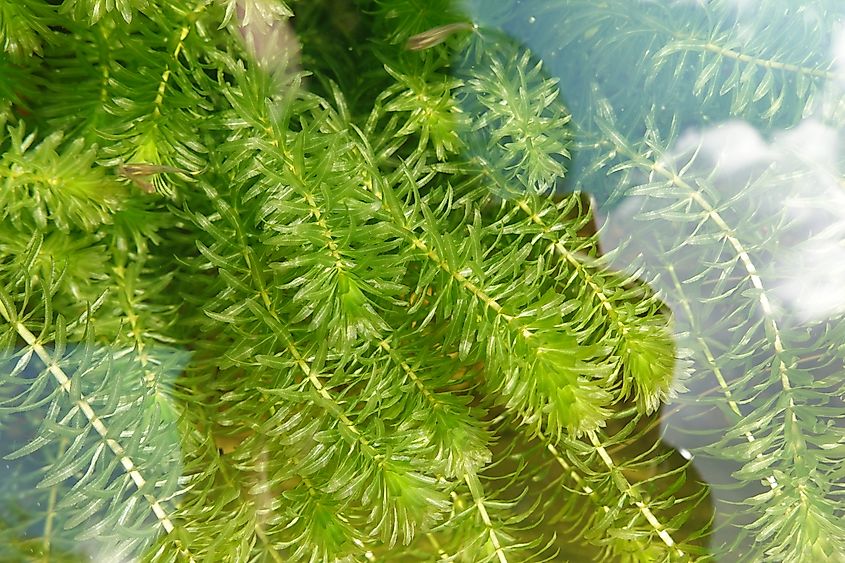
Hydrilla, a submerged aquatic plant and perennial herb with coarse, teethed leaves, can grow stems up to 30 feet long, forming dense, tangled mats. Originally introduced to Florida as an aquarium plant in the 1950s, it quickly spread, covering over 140,000 acres of Florida lakes and rivers by the 1990s. Hydrilla’s dense canopies block sunlight for other aquatic plants and lower oxygen levels in the water, which harms fish and other aquatic animals. Its rapid growth rate—over an inch per day—makes it one of the most invasive aquatic plants in the Everglades, disrupting aquatic habitats and biodiversity.
Old World Climbing Fern (Lygodium microphyllum)
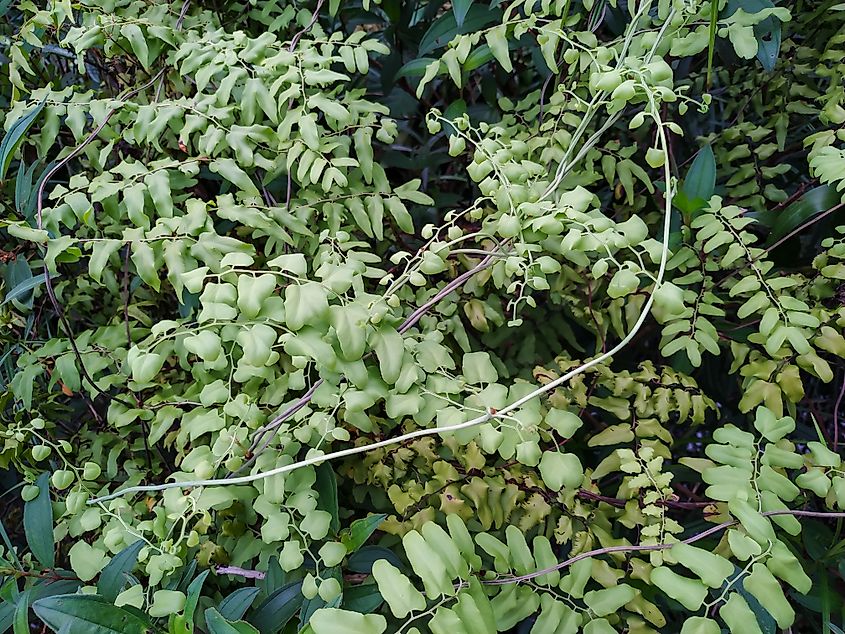
The old world climbing fern, native to tropical Asia, Africa, and Australia, has overtaken vast areas of southern Florida since its establishment in the mid-20th century. With fronds that can reach up to 90 feet in length, it grows over shrubs and trees, forming thick canopies that block sunlight and suffocate native vegetation. This fern’s thick blanket has made entire forests in the Everglades nearly invisible beneath it, causing extensive ecological disruption. Its rapid spread and ability to smother other plants make it one of the most challenging invasive plants to control in the Everglades.
Carrotwood (Cupaniopsis anacardioides)
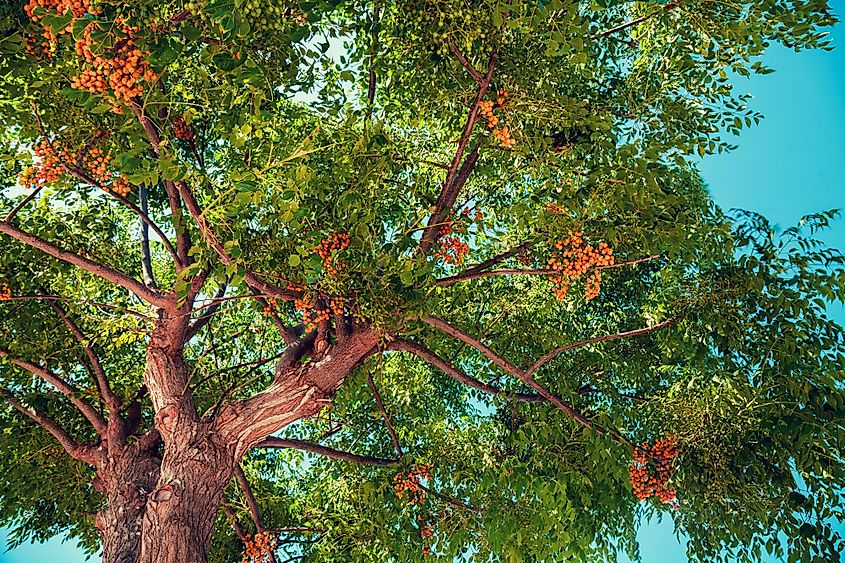
Originally introduced from Australia in the 1960s, carrotwood is a hardy tree that can thrive in diverse conditions, including drought, poor soil, shade, and periodic flooding. It features a distinctive trunk with dark gray bark on the outside and bright orange bark beneath. Growing up to 35 feet tall, carrotwood rapidly forms dense stands that crowd out native plant species, reducing biodiversity. Its spread across coastal areas in Florida threatens native habitats, and its resilience makes it particularly difficult to control. Carrotwood’s ability to adapt to various conditions allows it to invade a wide range of Everglades ecosystems.
Final Thoughts
While invasive species continue to jeopardize the rich biodiversity of the Everglades, national park and state officials are actively studying and managing these threats in a determined effort to combat the rapidly growing numbers of these non-native species. Through targeted removal projects, public education initiatives, and further biodiversity research, scientists are racing against the clock to save the native species that define this remarkable region. In the coming years, we will witness the impact of these efforts, with the hope of preserving hundreds of species for future generations.











